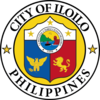Forbes Bridge
Department of Public Works and Highways - Iloilo City District Engineering Office

The Forbes Bridge is a historic bridge located in Iloilo City, Philippines. It was constructed in 1909 to replace the wooden Jaro Bridge, which had been built in 1875. The bridge served as a vital link between the districts of La Paz and Iloilo City Proper.[2] It is claimed to be the oldest concrete bridge in the country.[3]
History
During the Spanish colonial period, the estuary that meandered through Iloilo City was known as the Jaro River, as it marked the natural boundary for one of the original territories of the pueblo of Jaro. In 1587, a one-foot image of the Nuestra Señora de la Purificacion y Candelaria (Our Lady of Purification and Candles) was discovered in this body of water. Over time, the Jaro River came to be known as the Iloilo River.[4][5][6]
The construction of the Forbes Bridge was considered a significant development during its time. An American newspaper described it as "one of the most important causeways yet constructed in the islands." The bridge was built by W. H. Lambert & Co. at a cost of P100,000 and was completed in 1910. It spanned a length of 127 meters.[7][6]
In recognition of his contributions and leadership, the bridge was named after Governor General William Cameron Forbes. Governor General Forbes served as the Governor-General of the Philippines from 1909 to 1913. His name was bestowed upon the bridge to honor his role in the development and modernization of the region. The bridge was rehabilitated in 1975.[8]
Forbes Bridge stands as a testament to the engineering prowess of its time and continues to serve as an important transportation route in Iloilo City. It holds historical significance as a symbol of the city's growth and development during the early 20th century.[6]
References
- ^ a b "Detailed Bridge Inventory". Department of Public Works and Highways.
- ^ Funtecha, Henry F. (2006-10-05). "Roads and bridges in Iloilo during the American rule". Bridging the Gap. The News Today Online Edition. Retrieved 2023-07-13.
- ^ Salas, Vic (2022-12-07). "[Ilonggo Notes] 11 bridges over the Iloilo Esplanade". Rappler. Retrieved 2023-07-13.
- ^ Rosal-Sumagaysay, Joy (2008-02-01). "Viva la Candelaria de Jaro". The News Today Online Edition. Retrieved 2023-07-13.
- ^ Cf. Tamayo, Jojo (2016-05-16). "The Queen of Jaro: Nuestra Señora de la Candelaria". Arte Sacra Ph. Retrieved 2018-02-17.
- ^ a b c Egan, Eleanor Franklin (1910). The Manila Times: Investors and settlers edition (1st ed.). Manila: Times Publishing Company.
The Forbes Bridge was then described by an American newspaper as "one of the most important causeways yet constructed in the islands."
- ^ "Detailed Bridge Inventory". Department of Public Works and Highways. Retrieved 2023-07-13.
- ^ "DOT launches 7 Bridges of Blessings in Iloilo City". SunStar. 2013-06-10. Retrieved 2023-07-13.
- v
- t
- e
(The Most Loyal and Noble City of Iloilo)

- Arroyo Fountain
- Calle Real
- Camiña Balay Nga Bato
- Casa Mariquit
- Casa Real de Iloilo
- CPU Church
- Iloilo Business Park
- Iloilo Convention Center
- Iloilo Customs House
- Iloilo Museum of Contemporary Art
- Iloilo River Esplanade
- Jaro Belfry
- Jaro Cathedral
- Lopez Heritage House
- Molo Church
- Molo Mansion
- Museo Iloilo
- Old Iloilo City Hall
- Old Jaro Municipal Hall
- Plaza Libertad
- San Jose Church
- Primary and secondary schools
- Universities and colleges
- Western Visayas
- Philippines
 Category
Category












